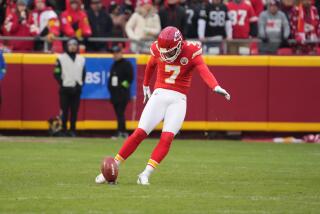Pro Football / Bob Oates : The NFL’s 45-Man Roster Limit Already Sparking Some Lively Debate
- Share via
Are 45 players enough for a pro football team? Or should the NFL return to last season’s 49-player roster limit?
They’re debating that in the league this year, sometimes bitterly.
One group, including the Raiders and 49ers, wants 49. The more conservative majority, wanting to save money and led by Lamar Hunt of the Kansas City Chiefs, insists on 45.
But both figures are swollen by comparison with those of former years. In the early days of the Rams here, the roster limit was 30 for a while, then 33. The AFL used to play with 30-man clubs. Earlier, George Halas’ Chicago Bears won some championships with 15 players.
In an 11-man sport, plainly, 49 are not needed--unless the object is higher quality.
“You need a big squad to practice this game properly (during the week),” Washington General Manager Bobby Beathard said. “That’s why the colleges carry 75 players. If your team has four wide receivers, and two or three of them are resting with little injuries, how is your defense going to practice pass defense?”
With some apprehension, the NFL is keeping an eye on the lawsuit filed this summer by an Ohio high school coach, Mike Currence, who was fired by the Massillon school district two years before the end of his contract.
Massillon paid Currence off, but he doesn’t just want the money. He wants the job and the money both--as specified in his contract.
If he wins his case, the next wave of fired NFL coaches will keep it in mind.
For more than 50 years, NFL clubs have held to a double standard.
In salary disputes with players, they customarily tell players under contract to report because a contract is a contract.
But when the need arises, they fire coaches under contract, regardless of the terms of the contract.
It is the view of Currence, a successful veteran coach in Ohio, that monetary payoffs don’t cover the embarrassment of being fired.
The Eric Dickerson case also brings into question the one-way aspect of virtually all NFL player contracts--all except the few that are guaranteed.
In most cases, a pro can be cut by the club anytime. He may hold a three-year contract providing for $200,000 annually--but only if he makes the roster.
The contract, in other words, protects the team from losing an athlete to another team. But it doesn’t protect the athlete from losing his job.
Football players are among the few in America required to make deals like this.
The way to beat the Washington Redskins, as the Dallas Cowboys proved the other night, is to get an early lead and force quarterback Joe Theismann to throw from behind.
By contrast, in an even game, the Redskins prefer to run the ball with John Riggins--except in low-risk passing situations.
When they fell behind at halftime in Dallas, 17-7, they benched Riggins and put the issue up to Theismann, whose interceptions led to a 44-14 rout.
The game’s key play was Dallas quarterback Danny White’s throw to wide receiver Mike Renfro for 55 yards and a touchdown with six seconds left in the second quarter, expanding the Cowboys’ lead from 10-7 to 17-7.
An error by Redskin coaches led to the play. With 52 seconds remaining in the half, they had the ball and could have called a clock-running ground play on third and 10 at their 14-yard line. Instead, they chose a pass, which stopped the clock when it fell incomplete.
Even a completed pass wouldn’t have done them much good there. But the worst happened when the Cowboys were given just enough time to score.
“We all lost this together,” Washington Coach Joe Gibbs said, doubtless thinking of his part in it.
If the TV networks are going to help the NFL officiate its games next season, they’ll have to be a little sharper than ABC was at Texas Stadium.
When Dallas running back Timmy Newsome fumbled the ball away on the play before the Cowboys’ first touchdown, ABC had it but didn’t show it live.
Then the first instant replay showed Newsome’s back. Since he fumbled the other way, that was inconclusive.
The next replay was conclusive but tardy.
It is the NFL’s plan next year to make a quick determination on controversial plays without slowing down the game.
Thus the networks will be most helpful if they select the right replays first.
Which calls to mind another problem with any plan involving commercial television as an aid to officiating. Suppose a TV director has bet on the fumbling team. Will he show the most helpful replay first? Will he show it fast?
The NFL conceivably shouldn’t lose control of its product--the game--even though there will be instances when an official’s call will be decisive on a key touchdown, as it was this time.
More to Read
Go beyond the scoreboard
Get the latest on L.A.'s teams in the daily Sports Report newsletter.
You may occasionally receive promotional content from the Los Angeles Times.










